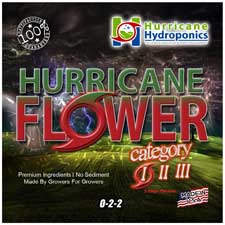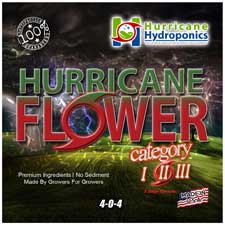Hurricane Flower
3-Part Flowering Concentrate System
Hurricane Hydroponics designed its Hurricane Flower, 3-part flowering concentrate system for all types of hydroponic systems. Nutrients contained in the flowering trio of the concentrate system are made from pharmaceutical grade components to ensure consistency and reliability.
Use of the Hurricane Flower 3-part system provides growers with an adjusted fertilizer solution system needed by the plant to successfully transition its carbohydrate, protein and energy production/allocation from the vegetative state to support optimum bud development, flowering and fruiting.
Plants undergo a significant transition during the flowering stage of their development. It is during this period where the peripheral (distal) parts of the shoot usually become sites of reproduction (versus the lower parts that remain vegetative). Vegetative growth rate will normally taper off considerably in favor of the development of the flowering parts.
This is also the period where dynamic metabolic changes occur — changes in the carbohydrate dynamics of plant tissue occur, amino acids and protein synthesis is redirected and energy requirements escalate.
Obviously the design of the nutrient solution must be altered during this period as the plant matures from a pure growth state to the flowering state and beyond. The nutrient solution composition and concentration must be adjusted to satisfy the complex changes in the elemental demand ratios of the plant.
While phosphorus is the element most associated with flower growth and production, nitrogen and potassium, along with the secondary nutrients and micronutrients, are all vital.
Key components of the Hurricane Flower system include:
Nitrogen (N)
The 3-part Hurricane Hydroponics flowering system is designed to allow the grower to gradually decrease the nitrogen-heavy ratios of base nutrients used during the vegetative state in favor of ratios that are higher in phosphorus and potassium. But the nitrogen levels are not eliminated.
How important is it to retain nitrogen in flowering nutrient solution strategies? Flowering plants still require nitrogen to continue photosynthesis in order to manufacture non-structural carbohydrates, amino acids and other nitrogenous compounds. It is well established that during the flowering period, reproduction is supported primarily by current photosynthesis — stored carbohydrates play a minor role and are used as reserves for fruit production or new vegetative growth.
Phosphorus (P)
Hurricane Hydroponics paid particular attention to phosphorus when we developed the Hurricane Flower system. Phosphorus is essential for the general health and vigor of plants. It is a vital component of energy production of plants. As a plant matures, phosphorus is redirected from vegetative tissues into the flowering and fruiting areas of the plant where high energy demand exists for the formation of seeds and fruit.
Phosphorus is a component of the complex nucleic acid structure of plants, which regulates protein synthesis.
Therefore phosphorus is deeply involved with stimulating the shift in plant processes and function from growth to flowering. Phosphorus promotes the development of additional flowering sites, especially during the early stages of flower production — ultimately improving flower formation as well as bud and seed production.
Improved root development, increased stalk and stem strength and increased resistance to plant diseases are also growth factors associated with phosphorus.
Phosphorous is the secret to bigger blooms. Our Hurricane Flower formulations and feeding schedules reflect its importance during this time frame.
Potassium (K)
Potassium is often associated with stimulating flowering. Potassium doesn’t directly initiate flower development, but it is vital to production during heavy fruiting and flowering.
Potassium is a catalyst for carbohydrate metabolism, so if there is insufficient potassium in the nutrient solution during the flowering stage, sugar production is reduced and your plants will not be provided the energy they need for fruit and flower development. Plant growth will slow down and the quality of fruits and flowers declines.
Potassium also promotes cell-wall thickening and is associated with strengthening of stems and protection of plants from diseases and insects.
Secondary Macronutrients
Although Calcium (Ca), Magnesium and Sulfur are considered secondary elements, their importance to successful crop production is equally important as N, P and K.
Calcium (Ca)
Calcium is needed for plant growth, participating in cell wall formation and cell division. It is used by the plants to maintain healthy roots, ensures the proper translocation of nutrients and carbohydrates within the plant, and activates a number of plant growth-regulating enzyme systems.
In substrates (soil or soilless mixes) it replaces hydrogen ions on soil surface — helping to reduce reserve acidity.
Magnesium (Mg)
Magnesium is directly tied to the energy status in plants. It is an essential constituent of the chlorophyll molecule. It also essential for phosphate availability and metabolism as well as cell division and protein formation. It is also linked to plant respiration and the activation of several enzymes systems.
Sulfur (S)
Your hydroponic or horticultural container crop nutrient system is only as good as its weakest link. The weak link in fertility programs is often overlooked — sulfur.
Sulfur is immobile in the plant so it must be supplied throughout critical stages of development — including flowering. Sulfur is included within the Hurricane Flower concentrate system because it plays a wide variety of vital roles during flowering and bud development.
Sulfur is a molecular building block in a number of amino acids, metabolites, proteins, hormones and vitamins and serves as a catalyst in chlorophyll production.
It is highly important to avoid or reduce stress during flowering. If plants are under stress, they will often reduce flowering as a defense mechanism. Synthesis of two key amino acids directly linked to relief of stress in plants require sulfur.
Sulfur also plays a central role in the conversion of nitrate to amino acids. Simply stated, without sufficient supplies of sulfur, plants cannot efficiently use nitrogen and other nutrients. Although nitrogen levels are reduced during the flowering stage, it is important to maintain the efficiency of the photosynthetic machinery inasmuch as reproduction is supported primarily by current photosynthesis, not stored carbohydrates.
Don’t let sulfur be the missing link in your nutrient system
Micronutrients
Micronutrients such as Iron (Fe), Zinc (Zn), Copper (Cu), Molybdenum (Mo); and Boron are included in the Hurricane Flower formulations but only in trace amounts. Where required our micronutrients are chelated using amino acids to improve their movement into and throughout the plant. These elements effect growth, reproduction, and the effect that other nutrients have on the plant.
AminoN L-Amino Acids
The basic component of living cells in plants is proteins. Amino acids are the building blocks for the synthesis of structural and enzymatic proteins necessary for plant growth, reproduction and general metabolic function.
AminoN has been included within the Hurricane Flower system to provide a rapid source of the full complement of L-amino acids required by the plant to generate a wide variety of products, including proteins, pigments, nucleotides, enzyme cofactors, hormones, structural components and defensive agents.
These fully assembled L-amino acid protein precursors lower energy requirements by the plant during the vegetative stage by avoiding high energy requirements needed for synthesis of similar amino acids by scratch (de novo synthesis). In addition to the immediate use of pre-assembled amino acids provided in the Hurricane Flower formulations, plants also fully capable of breaking down AminoN L-amino acids and re-assembling the parts to match site specific amino acid configurations — effectively and efficiently remobilizing nitrogen and other elements to suit the specific needs of the plant during different stages of growth and reproduction.

Program Flexibility
We at Hurricane Hydroponics respect the needs of growers to have the ability to modify their nutrient solutions during all stages of plant growth and development.
The Hurricane Flower nutrient system is fully customizable, ensuring key nutrients are available to support key phases of flower and fruit development. The composition and concentration of the nutrients can be easily adjusted to align with your culture system, your crop’s development stage and environmental conditions.
The flexibility built into the Hurricane Flower concentrate system is highly effective for production of flowering crops. The accurate control of nutrient inputs offered by the Hurricane Flower growing system preserves the main advantage of hydroponic growth systems.




